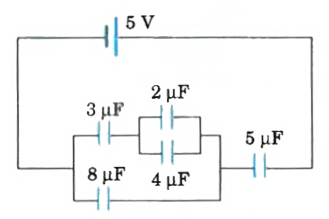In the net work three identical capacitors are connected as shown. Each of them can withstand to a maximum 100V potential difference. What is the maximum voltage that can be applied across A and B so that no capacitor gets spoiled.
 .
.
Let qmax be the max-charge supplied by the battery between A and B so that no capacitor gets spoiled.
For each capacitor
qmax=CV0=C(100)=100C
For the combination qmax=Cequivalent(Vmax)
100C=23C(Vmax)⇒Vmax=150V
Among 150V, potential difference across parallel combination is 150V, potential difference across parallel combination is 50V and the potential difference across the other capacitor is 100V.
Topper's Solved these Questions
- CAPACITANCEBook:NARAYNAChapter:CAPACITANCEExercise:C.U.Q
Explore 54 Videos
- CAPACITANCEBook:NARAYNAChapter:CAPACITANCEExercise:Assertion & Reasoning
Explore 16 Videos
- ATOMS Book:NARAYNAChapter:ATOMS Exercise:EXERCISE -4
Explore 47 Videos
- COMMUNICATION SYSTEMBook:NARAYNAChapter:COMMUNICATION SYSTEMExercise:Level-II(H.W)
Explore 25 Videos
Similar Questions
An RC circuit is made using five identical capacitors, each of which can withstand a maximum voltage of 2 volts. The maximum voltage which can be safely applied across points A and B is

View SolutionThree uncharged capacitors are connected in the circuit as shown. What should be the value of C3(in uF) so that potential difference across each capacitor is same
View Solution
Knowledge Check
All six capacitors shown are identical. Each can withstand maximum 200 volts between its terminals. The maximum voltage that can be safely applied between A and B is
 A1200VB400VC800VD200V
A1200VB400VC800VD200VWhen two identical condensers are connected in series choose the correct statement regarding the working voltage (the maximum p.d that can be applied to a condenser) and the capacity.
Aworking voltage increases, capacity increasesBworking voltage increases, capacity decreasesCworking voltage decreases, capacity increasesDworking voltage decreases, capacity decreasesIn the arrangement shown, a potential difference is applied between points A and B. No capacitor can withstand a potential difference of more than 100 V
 AThe magnitude of the maximum potential difference that can exist between points A and B is 300 VBThe maximum potential difference that can exist across C2 si 50 VCThe maximum charge that can be stored by C3 is 2 mCDThe maximum energy that can be stored in the three capacitor arrangement is 190 mJ
AThe magnitude of the maximum potential difference that can exist between points A and B is 300 VBThe maximum potential difference that can exist across C2 si 50 VCThe maximum charge that can be stored by C3 is 2 mCDThe maximum energy that can be stored in the three capacitor arrangement is 190 mJ
Five capacitors are connected across a battery of 5V as shown in figure (o). Calculate the potential difference across the plates of the 5μF capacitor.

View SolutionThree capacitors of 10,15 and 30 μF are connected in series and on this combination a potential difference of 60 V is applied. Calculate the charge, potential difference and energy stored on each capacitor.
View SolutionA 10μF capacitor can withstand a maximum voltage of 100 V across it,whereas another 20μF capacitor can withstand a maximum voltage of only 25 V. What is the maximum voltage that can be put across their series combination ?
View SolutionThree 2Ω reistors , A,BandC, are connected as shown in (Fig. 3.44). Each of them dissipates energy and can withstand a maximum current that can flow through the three resistors ?
 .
.
View SolutionN identical capacitors are connected in parallel which are charged to a potential V. If these are separated and connected in series then what potential difference will be obtained?
View Solution

